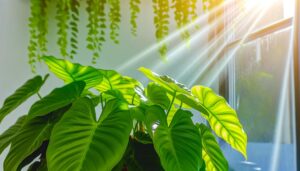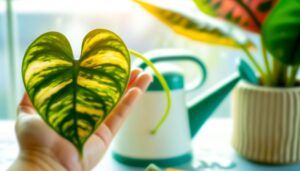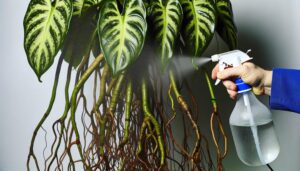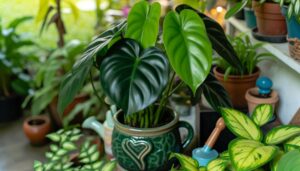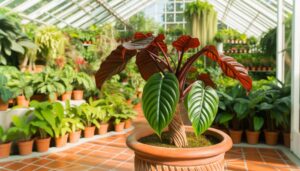How Do I Care for a Philodendron Glorious? Detailed Guide!
Proper care for a Philodendron Glorious involves meeting its distinct needs. Make sure the plant receives bright, indirect light, avoiding direct sunlight.
Water when the top inch of soil is dry and use a well-draining mix of peat moss, perlite, and orchid bark. Maintain a temperature range of 65-80°F and 60%-80% humidity.
Utilize a hygrometer and humidifier if needed. Conduct weekly pest inspections and manage diseases by removing affected leaves and applying suitable treatments.
Propagate via stem cuttings, ensuring humidity and ideal light during growing seasons. Seasonal care adjustments are crucial for thriving health; there’s much more to master in thorough plant care.
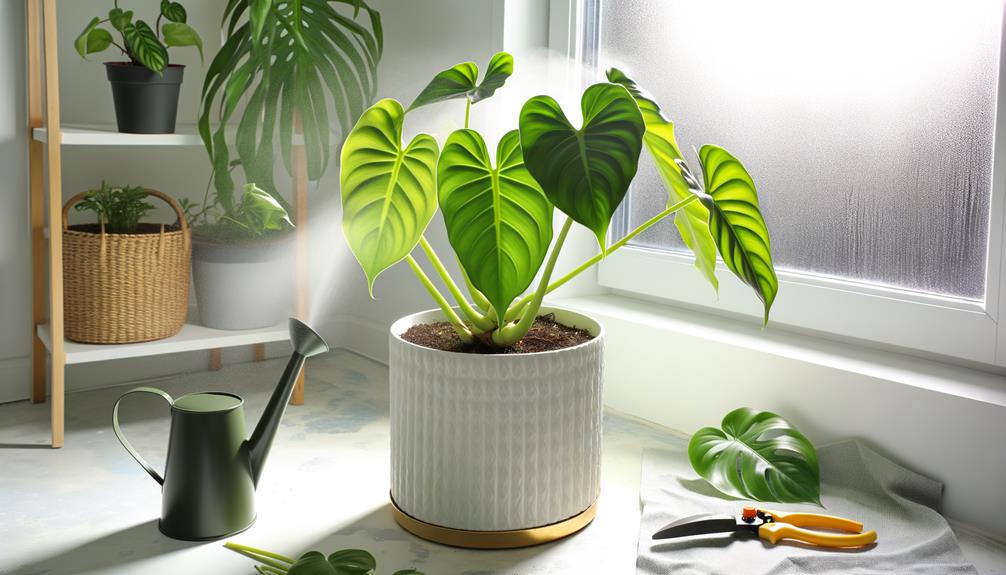
Key Takeaways
- Place in bright, indirect light; avoid direct sunlight to prevent leaf scorching.
- Water when the top inch of soil is dry; use distilled or rainwater.
- Maintain temperatures between 65-80°F and humidity levels between 60%-80%.
- Check for pests weekly; use isopropyl alcohol or insecticidal soap for removal.
- Use well-draining, aerated soil mix with peat moss, perlite, and orchid bark.
Light Requirements
For best growth, Philodendron Glorious requires bright, indirect light, as direct sunlight can cause leaf scorching and hinder its development. Best light conditions can be achieved by placing the plant near an east or north-facing window, ensuring filtered sunlight through sheer curtains.
This positioning allows the plant to photosynthesize effectively without exposure to intense rays, which can lead to chlorophyll degradation and subsequent leaf damage.
Utilizing artificial grow lights can supplement natural light, particularly in lower-light environments. It is important to monitor the plant’s foliage; pale or yellowing leaves indicate insufficient light, whereas brown, crispy leaf edges suggest excessive light.
Consistent light levels promote healthy growth and vibrant foliage, essential for those dedicated to providing ideal plant care.
Watering Schedule
Establishing an ideal watering schedule for Philodendron Glorious necessitates a careful balance to prevent root rot while ensuring sufficient hydration. This tropical plant thrives in consistently moist, but not waterlogged, soil. Water thoroughly when the top inch of soil feels dry. Avoid letting the plant sit in standing water, as this can lead to root diseases.
| Season | Frequency | Notes |
|---|---|---|
| Spring | Every 7-10 days | Increased growth phase |
| Summer | Every 5-7 days | Higher evaporation rate |
| Fall/Winter | Every 10-14 days | Reduced metabolic activity |
Using distilled or rainwater can prevent mineral buildup. Monitor the plant’s leaves for signs of over or underwatering, such as yellowing or wilting, and adjust the schedule accordingly.
Ideal Temperature
For best growth, Philodendron Glorious thrives in a temperature range of 65-80°F (18-27°C).
Sustained exposure to temperatures outside this range can lead to physiological stress, impacting both foliage development and overall plant health.
Additionally, abrupt temperature fluctuations should be minimized to prevent cellular damage and maintain consistent metabolic function.
Optimal Temperature Range
Maintaining an ideal temperature range between 65°F and 80°F is important for the healthy growth of Philodendron Glorious. This temperature spectrum supports best metabolic functions, including photosynthesis and nutrient uptake.
Ensure consistent indoor temperatures by using a reliable thermometer to monitor the environment. During colder months, avoid placing the plant near drafty windows or doors to prevent exposure to lower temperatures that could inhibit growth.
Conversely, during warmer months, utilize air conditioning or fans to keep the temperature from exceeding the upper limit. High humidity levels, ideally between 60% and 80%, should be maintained to mimic the plant’s natural tropical habitat.
These conditions will promote robust foliage development and overall plant vitality.
Temperature Fluctuation Effects
Sudden temperature changes can greatly stress Philodendron Glorious, disrupting its physiological processes and leading to reduced growth and potential foliar damage. This species thrives in stable conditions, ideally maintaining a temperature range of 65-80°F (18-27°C).
Abrupt shifts, especially drops below 55°F (13°C) or spikes above 85°F (29°C), can impair photosynthesis and nutrient uptake. To mitigate these risks, avoid placing the plant near drafty windows, heating vents, or in direct sunlight. Utilize temperature-regulating tools, such as thermostats and hygrometers, to ensure environmental consistency.
Humidity Needs
Best humidity levels for Philodendron Glorious range between 60% and 80%, essential for maintaining its lush foliage and overall health. This tropical species thrives in high humidity environments, mimicking its native habitat.
To achieve ideal conditions, utilize a hygrometer to monitor ambient humidity. Employ a humidifier if necessary to maintain consistent moisture levels. Additionally, grouping plants together can create a microenvironment with increased humidity.
Regular misting with distilled water helps to prevent mineral buildup on leaves. Ensure proper air circulation to avoid mold and fungal issues. Placing the plant on a pebble tray filled with water can also elevate humidity around the plant.
Adhering to these practices will promote vigorous growth and vibrant foliage.
Soil Preferences
Given that ideal humidity is vital for Philodendron Glorious, selecting the appropriate soil mix is equally significant to promote the plant’s health and growth.
Philodendron Glorious thrives in well-draining, aerated soil to prevent root rot and ensure best nutrient uptake. A recommended mix includes equal parts of peat moss, perlite, and orchid bark. Peat moss retains moisture while providing necessary organic matter; perlite enhances aeration and drainage; orchid bark supports root structure and prevents soil compaction.
Incorporating charcoal can further aid in keeping the medium fresh and free of toxins. Regularly check the soil moisture, aiming for a consistently moist but not waterlogged environment. Proper soil composition is essential for maintaining a thriving Philodendron Glorious.
Fertilizing Tips
Proper fertilization is essential for guaranteeing the strong growth and vivid foliage of Philodendron Glorious. Utilize a balanced, water-soluble fertilizer with an N-P-K ratio of 20-20-20, diluted to half strength.
Administer the fertilizer bi-monthly during the active growing season, which spans from spring to early autumn. Cease fertilization during the plant’s dormancy period in winter to prevent nutrient overload.
Monitor for signs of nutrient deficiency, such as yellowing leaves, and adjust the fertilization regimen accordingly. Organic alternatives, such as compost tea or fish emulsion, can also be beneficial, providing micronutrients essential for peak growth.
Always ensure the soil is moist before application to avoid root burn and enhance nutrient absorption.
Pruning Guidelines
Maintaining the health and aesthetic appeal of Philodendron Glorious also involves regular trimming to remove dead or yellowing leaves, control its size, and encourage bushier growth. Utilize sterilized trimming shears to make clean, precise cuts just above a leaf node or stem junction. This promotes faster healing and minimizes the risk of infections.
Aim to trim during the plant’s active growing season in spring or early summer. Remove any leggy, elongated stems to enhance the plant’s fullness. Additionally, discard any fallen debris and leaves to prevent fungal growth.
For best outcomes, avoid over-trimming; retain at least one-third of the foliage to ensure continued photosynthesis and robust development. Consistent trimming fosters a healthy, vibrant Philodendron Glorious, enhancing its ornamental value.
Repotting Instructions
Repotting a Philodendron Glorious should be done every 1-2 years to accommodate its growth and maximize root health.
Begin by selecting a pot that is 1-2 inches larger in diameter than the current one to allow adequate space for root expansion.
Utilize a well-draining soil mix, ideally composed of peat, perlite, and orchid bark, to ensure proper aeration and moisture retention.
Gently remove the plant from its existing pot, carefully detangling the roots if they are compacted.
Place the plant in the new pot, making sure that the root ball sits centrally and at the same depth as previously planted.
Fill in with the soil mix, firming it gently around the roots to eliminate air pockets.
Water thoroughly to settle the soil.
Pest Control
Effective pest management for a Philodendron Glorious involves regular examination for common pests such as aphids, spider mites, and mealybugs, which can impair the plant’s health to a large extent.
To maintain plant vigor, follow these steps:
- Examination: Conduct weekly checks under leaves and along stems for early signs of infestation. Use a magnifying glass for detailed inspection.
- Cleaning: Remove pests manually using a cotton swab dipped in isopropyl alcohol. Ensure thorough cleansing to prevent recurrence.
- Treatment: Apply insecticidal soap or neem oil bi-weekly as a preventive measure. Guarantee application covers all plant surfaces, including undersides of leaves.
Adhering to these practices will greatly reduce pest-related issues and promote strong growth.
Common Diseases
Philodendron Glorious is susceptible to several common diseases, the most prevalent being fungal leaf spot and root rot.
Fungal leaf spot manifests as necrotic lesions on the foliage, necessitating prompt removal of affected leaves and application of fungicides.
Root rot prevention involves ensuring ideal drainage and avoiding waterlogged soil conditions to maintain root system integrity.
Fungal Leaf Spot
Fungal Leaf Spot, a prevalent disease in Philodendron Glorious, manifests as small, dark lesions on the foliage, which can coalesce into larger necrotic areas if left untreated. Effective management requires immediate action to prevent widespread damage.
Begin by isolating the affected plant to restrict pathogen transmission. Implement the following measures:
- Prune infected leaves: Use sterilized pruning shears to remove diseased foliage, ensuring cuts are made into healthy tissue.
- Improve air circulation: Position the plant in a well-ventilated area to decrease humidity levels, reducing fungal spore viability.
- Apply fungicide: Utilize a broad-spectrum fungicide, adhering strictly to manufacturer instructions to safeguard against further fungal proliferation.
Root Rot Prevention
Maintaining root rot in Philodendron Glorious necessitates vigilant monitoring of soil moisture levels, as excessive watering is a primary catalyst for this debilitating condition.
Employ well-draining soil mixtures with high organic content to enhance aeration.
Implement a watering schedule that allows the top 1-2 inches of soil to dry out between waterings.
Utilize containers with ample drainage holes to prevent water stagnation.
Regularly inspect the roots for signs of rot, such as browning or mushiness. If detected early, trim away affected roots using sterilized tools and repot the plant in fresh soil.
Additionally, avoid placing the plant in low-temperature environments where evaporation rates are reduced, exacerbating moisture retention.
Proper root maintenance secures the Philodendron Glorious remains vibrant and healthy.
Propagation Methods
To propagate Philodendron Glorious effectively, one must employ stem cuttings, a method that guarantees genetic consistency and robust root development. Begin by selecting a healthy, mature stem with at least two nodes.
Using sterilized pruning shears, cut below the node at a 45-degree angle to facilitate prime water absorption. Make sure each cutting measures approximately 4-6 inches.
Follow these steps:
- Prepare the cutting: Remove any lower leaves to expose the nodes, as these will develop roots.
- Rooting medium: Place the cutting in water or a well-draining potting mix, making sure the nodes are submerged.
- Maintain humidity: Cover the cutting with a plastic bag or place it in a propagator to maintain high humidity and encourage root growth.
These steps guarantee successful propagation.
Seasonal Care Tips
Seasonal adjustments are critical for the best growth of Philodendron Glorious, necessitating modifications in light levels, watering frequency, and fertilization schedules.
During the growing season (spring and summer), increase light exposure while ensuring indirect lighting to prevent leaf burn, and elevate watering frequency to maintain consistent soil moisture.
Conversely, in the dormancy period (fall and winter), reduce watering intervals and curtail fertilization to align with the plant’s decreased metabolic activity.
Adjusting Light Levels
Optimizing light exposure for your Philodendron Glorious is crucial, as the plant’s phototropic sensitivity requires adjustments with seasonal shifts to guarantee robust growth. During the spring and summer months, place the plant in bright, indirect light to stimulate photosynthesis without causing leaf burn.
Conversely, in the autumn and winter, reposition the plant closer to windows to compensate for reduced daylight hours.
To effectively manage light levels, consider the following:
- Monitor Light Intensity: Use a light meter to ensure a consistent range of 1000-2000 lumens.
- Adjust Window Placement: Move the plant to east or west-facing windows for optimal light exposure.
- Utilize Artificial Lighting: Supplement natural light with grow lights, especially during shorter days.
Watering Frequency Changes
Adjusting the watering frequency for your Philodendron Glorious is crucial to accommodate its varying hydration needs throughout the year.
During the active growing season, typically from spring to early fall, maintain consistent soil moisture by watering when the top inch of soil is dry. This encourages prime growth and nutrient uptake.
In contrast, during the dormant period in winter, reduce watering frequency to prevent root rot; allow the top two inches of soil to dry out between waterings. Employing a moisture meter can be advantageous to monitor soil hydration precisely.
Additionally, ensuring proper drainage to avoid waterlogged conditions, as Philodendron Glorious is susceptible to root rot. Adapting these practices guarantees your plant remains vibrant and healthy through seasonal changes.
Fertilization Schedules
Maintaining an ideal fertilization schedule is essential to supporting the Philodendron Glorious’s growth and overall health throughout the different seasons. During the active growing season, typically spring and summer, apply a balanced, water-soluble fertilizer at half strength every 4-6 weeks.
In contrast, reduce fertilization frequency during fall and winter to every 8-10 weeks, ensuring the plant’s metabolic activity aligns with seasonal dormancy. Adhering to these guidelines will prevent nutrient imbalances and foliage burn.
To achieve the best nutrient uptake, follow these steps:
- Dilute Fertilizer Properly: Always dilute fertilizer to half strength to avoid over-fertilization.
- Monitor Soil Moisture: Fertilize only when the soil is moist to enhance nutrient absorption.
- Observe Plant Response: Regularly inspect foliage for signs of nutrient deficiency or excess.
Glorious Jungle Philodendron
The Glorious Jungle Philodendron is a hybrid plant combining features of Philodendron Gloriosum and Philodendron Melanochrysum. It has large, velvety, heart-shaped leaves with prominent veins.
It prefers bright, indirect light, high humidity, and consistently moist but well-draining soil. Ideal temperatures range from 65-80°F (18-27°C). Regular feeding during the growing season and occasional pruning help maintain its lush appearance.
Conclusion
To sum up, the philodendron glorious flourishes under particular conditions: ample, indirect sunlight, regular watering, temperatures ranging from 65-80°F, elevated moisture levels, and well-draining soil.
Efficient pest management and attentiveness to typical illnesses additionally safeguard plant vitality. Reproduction is commonly accomplished through stem clippings.
Notably, philodendrons have the ability to eliminate up to 87% of airborne pollutants within 24 hours, rendering them not just aesthetically pleasing but also advantageous for indoor air purity. Appropriate seasonal maintenance can enhance development and lifespan.

